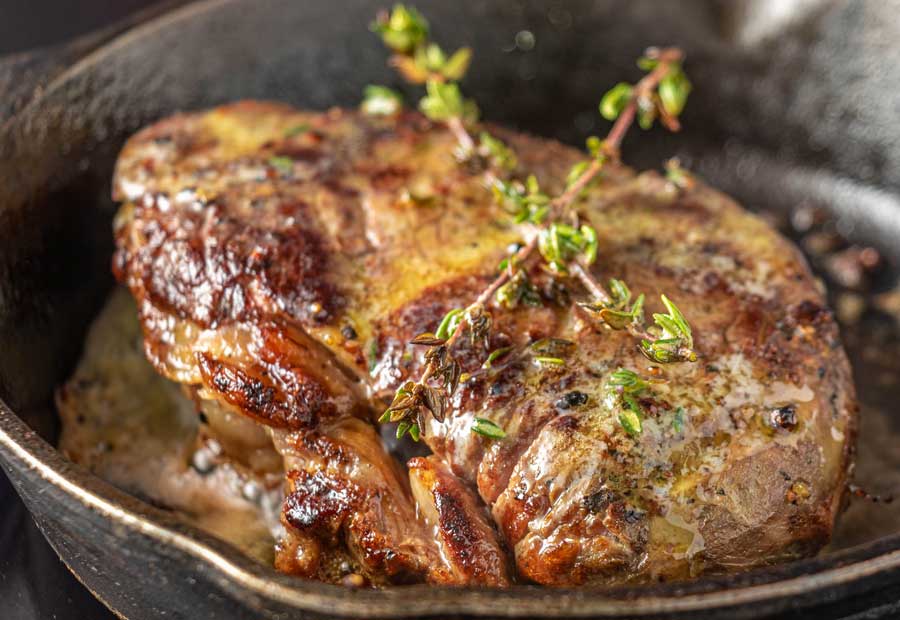Step into the kitchen, a space where aroma becomes orchestra, and heat the conductor. Today, we're composing a symphony of flavor guided by the invisible hand of the Maillard reaction. This dance of sugar, protein, and heat paints culinary masterpieces upon the canvas of our food, transforming the ordinary into the extraordinary.
In the Sizzling Crucible: Where Bison Steaks Sing Their Meaty Song
Imagine, if you will, a bison steak. Not just any steak, mind you, but a prime cut, marbled with just the right amount of fat, glistening with anticipation on a cast-iron pan screaming hot. As the steak hits the metal, a sizzle erupts, the first note in the Maillard concerto. Like tiny embers, sugars caramelize, whispering tales of toasty warmth and nutty intrigue. Amino acids, the very essence of protein, break down in the fiery crucible, unleashing a kaleidoscope of volatile compounds. Notes of caramel and chocolate tango with whispers of smoke and spice, painting the steak in a new light, a masterpiece of Maillardized flavor.
But the maestro, the Maillard reaction, is a meticulous one. It demands a high heat, above 300°F, to coax forth its full potential. So, we preheat our pan, a stage primed for the steak's grand entrance. Pat it dry, a silent respect for the heat's power, and season generously, a sprinkle of salt and pepper, the first instruments tuning up. Then, the sear, a dance of flame and flesh, for a few precious minutes per side. Each sear mark, a brushstroke of golden brown, a testament to the Maillard magic.
But the symphony isn't over yet. We let the steak rest, a moment of anticipation as the juices redistribute, the flavors meld. And then, the first bite, a revelation. Tender, juicy, bursting with a depth of flavor transcending mere meat. This is the Maillard masterpiece, a carnivore's concerto composed in the sizzling crucible of the pan.
Beyond the Steakhouse: Maillard's Magic Touches All It Kisses
The Maillard muse, however, is not a one-trick pony. It whispers its secrets to a chorus of ingredients, each singing its own delicious aria. From humble flour to a symphony of crust and crumb, bread owes its soul to the Maillard magic. Sugars caramelize, painting the crust with a golden hue and whispering tales of honey and toffee. Amino acids join the chorus, adding notes of wheat and earth, a counterpoint to the sugar's sweetness. This is the song of bread, a harmony of textures – the shattering crackle of the crust, the yielding softness of the crumb – each bite a testament to the Maillard maestro.
And then there's coffee, the dark, aromatic muse of the morning. Those humble green beans, once silent and stoic, are transformed in the fiery embrace of the roaster. The Maillard maestro conducts a whirlwind of flavor, coaxing sugars into caramel whispers and amino acids into a vibrant aria of chocolate, fruit, and spice. These are the notes that dance on your tongue, the melody that lingers in your cup, a testament to the transformative power of heat and time.
A Toast to the Maestro: Louis Camille Maillard and the Pronunciation Puzzle
But before we lose ourselves entirely in the symphony of flavor, let's raise a glass, or perhaps a steaming mug of coffee, to the man who unlocked the secrets of the Maillard reaction. Louis Camille Maillard, a French chemist born in 1878, stumbled upon this culinary alchemy while studying the browning of sugar. His name, however, presents a pronunciation puzzle. Some say "May-yard," others "My-yard," and still others opt for the French "Mai-yahr." No matter your chosen pronunciation, let it be a delicious ode to the man who gifted us the science of flavor.
So, the next time you savor the caramelized crust of a steak, the golden perfection of a loaf of bread, or the rich aroma of your morning coffee, remember the Maillard reaction. It's the invisible hand that guides our palates, the secret ingredient that transforms the mundane into the magnificent. Go forth, experiment, and let your kitchen become a stage for the Maillard symphony. With a little practice, you too can become a maestro of flavor, composing culinary masterpieces that sing on the tongue.
And remember dear reader; the music is always better shared. So, gather your friends and family, crank up the heat, and let the Maillard symphony begin!


